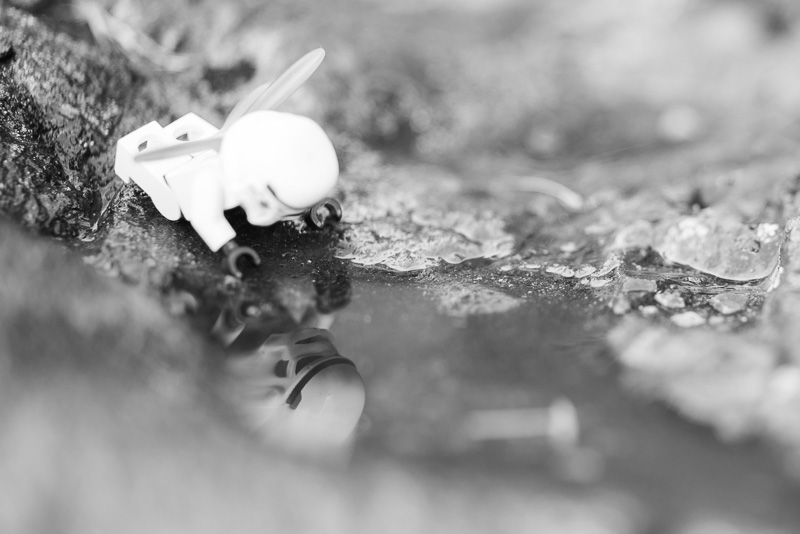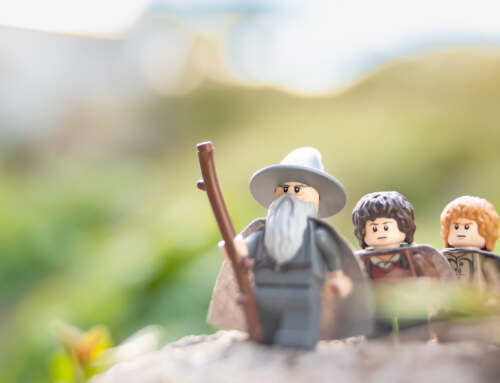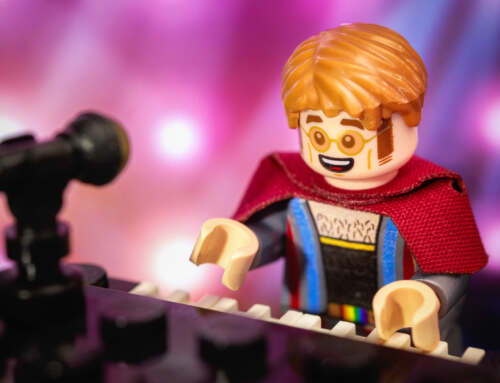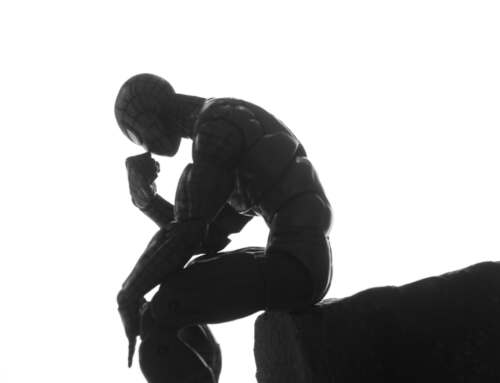I read an article on The Photographers blog about avoiding chasing trends in photography and the lesson they were trying to teach is, in my view, summed up by a quote by Gregory Heisler, “shoot the photos you can’t help but shoot.” Reading this article made me think that toy-photography is just a trend; a trend in photography that is made possibly by a combination of digital cameras and the Internet.
Was there toy-photography before the internet? Is there a genre called toy-photography?
As I see it, toy-photography is no genre in it self it’s part of a genre in art called still life, because what we do is create pictures with little bits of plastic. We create still life’s the same way as painters and photographers always have, but instead of flowers, fruits, bowls and so on, we use children’s toys. You may object that your toys are alive and that you see them as living people. I get that and truly understand your feelings because I also love my toys and I see them as my friends… but for most people they are merely inanimate plastic pieces. Toys are made for children to play with. So from my point of view the genre “toy-photography” doesn’t exist, what we are actually practicing is still life photography, with toys as our main object (motive). While we may think what we are doing is fresh and novel, it actually has been around for a while. I have seen beautiful still life’s made with toys created in the sixties by other photographers like Christer Strömsholm, so making still life´s with toys isn’t something that came with the internet. What we have that photographers before us haven’t had, is a easy way to meet like minded individuals through the internet and social media. Back to the question that started all of this: Is there a trend among photography to make still life’s with toys?
I don’t know, but in some ways I think so, especially when I read Mike’s statement about this being a “starter” genre, “give a child a
camera and there’s a high likelihood that they’ll take some bad photos of toys “. Through toys, children and adults, become photographers. With the Internet and social media, we see others doing the same thing, taking pictures of toys. That in it self may be enough to talk about “toy-photography” as a trend, easy to join and follow.
But if my assumption that what we do (when we as photographers takes pictures of toys) is part of a “trend” is correct, that doesn’t mean that your pictures of toys are only a part of this trend. You can, just as I do, follow Heisler’s advice and only shoot the photos you can’t help but shoot.
Kristina
What do you think? Is photography of toys as motives just a trend in photography? And if so what happens when it ends?








Kristina,
I will need to disagree with you and your implication that Toy Photography his only a trend. The word trend is rather negative and implies trendy or short lived as well. I wrote 18 months ago about how much I was seeing toy imagery in all aspects of art, not just photography. http://www.stuckinplastic.com/2014/07/a-brave-new-toy-world/ A link in case you missed this one.
I have a lovely book in my library entitled Crazy Photography and at least a 1/3 of the photographers use toys in some manner in their work. Everything from Barbies, to cars to cheap tourist souveniours; they all have an element of childhood playfulness in them. What all these artists have in common is they are following their own vision. They are using toys to tell the stories that only they can tell. We talk a lot on the blog about being true to your own vision, or at least I do, and I think toys can connect you to a movement, but also leave plenty of room for artistic honesty and originality.
I am sure if given a few minutes I can come up with dozens of toy photographers who are following their own vision. What I think this blog post you reference is criticizing, can be seen in any photographic genre. Some trends that have swept through the photographing community are slow shutter speed water, macro water droplets, HDR, follow me, from where I stand etc….
I know you are wed to the idea of Still Life and photography coming together in your work through toys, but toy photography can be so much more than that. War Toys Project is another example of using toys to create art (notice i didn’t say photography here).
I would like us to move away from trying to label what we do. We should be more concerned about producing work, getting better at our craft and let the art historians or the art critics coin the phrase that will define what this cross platform movement is. It is not for us to define our selves, it is only our task to create work that is true to our personal vision that hopefully adds something to the larger dialogue of life.
This is coming from the woman who shot underwater nudes for 20+ years. Who know where I will go next. But right now I don’t care, I am enjoying the present and I’m trying to improve and grow as an artist. The future can take care of itself.
Shelly
I don’t say that artist isn’t using toys, I mean that this is something that artist have done for some time. My thought is that we see a trend in photography of using toys as motives. And I don’t value that. All I say is that it can be worth to think about if Why we do pictures. I have to do that all the time because I’m always questing myself, not you or your work.
About the still life issue we can agree on disagreeing here. I don’t see this is a uniqe genre, but I’m propobly wrong.
Kristina
K
I agree artists have been doing this for some time and as toys have become ubiquitous more artists are using them. It only make sense. When I look at art here in the states I see toy / childhood imagery across all genres, not just photography. This is why I think the trend the genre is not specifically photography related. We only see it as such because that is who we are. I think we all need to question what we do and act with intention. We need to acknowledge our influences no matter how far flung. I think we are as close to still life photographers as anything, I would rather have someone on the outside name us, rather than us name ourselves. It would carry more weight in the long run. It is for an art historian to show us how we fit into the larger picture (if we do at all). It is only for us to keep questioning who we are and what we are doing.
As for the question is TP a trend, only time will tell as to whether it is or a convergence that will lead to something greater.
A great post that has lead to a wonderful discussion!
S
xo
Thanks Shelly 🙂
I have no idea what will happen in the future. But I can easily imagine that no matter what happens, now that toy photography has “publicly” emerged, as long as there are toys (and cameras and the Internet) there will be people to take photos of them.
I agree that the closest well established genre is still life and we probably have a lot to learn from this genre. At the same time I have many concerns classifying it as such. When I look to still life photography what strikes me most is that what is commonly identified as still life contrasts a lot with toy photography. For me the matter is not whether or not toys are alive, but that they are depicted as living beings. We tell stories of living people with our toys even though they are not. For me this is something completely different from usual still life which looks lifeless to me.
So I don’t know whether or not toy photography is a genre of its own, a subgenre of still life, or a trend. Surely there are a lot similarities between creating still life and toy photography, which means there is a lot to learn from still life photography. However up to now I had difficulties trying to connect my photography with other traditional kind of photography, still life more than anything.
Thanks for giving you perspective on my thoughts I really like ’em. I agree with having a hard time realting to still life’s as such but I think one of the reasons is that we don’t get the context, and we all have a context around toys – Toy Story, our childhood, they are symbols of us, our time and in many ways ourself and the world we live in. I don’t mean that apples in a traditional still life represent a human-life, but I think the reference to a context we don’t always connect to, and we have poor or little knowledge about how to make sense of the symbols. We don’t know that the Swan is a symbol of betrayal, we don’t see the flys at the table and what the represent. And when we don’t understand we tend to say that is something I don’t connect to. And if we look at what we do, who will know who Indiana Jones is in 300 years? or a Stormtrooper – who will know. What is ordinary well known things in our time will be harder to get once people don’t have the references. Will our pictures stand the time… I don’t know but I think it worth thinking about.
I use my minifigs to tell a story, explain a feeling or just something nuts. I can’t do that with people and I am not good at telling people what to do anyway so this is my way of expressing myself. Been doing it for myself and did not know that other people did it to. I know better since Vaxholm, so trend or not I’ll think I keep on taking my toyphotos. How else could I express myself. Hugs to all!
I have to hug you back, Stefan! Yes we do it as a way of expressing ourself and Toys are great for that 🙂 Thanks for sharing your thoughts 🙂
This is a really interesting post and I kinda see the relation to still life photography. I’m more of an amateur photographer and I really like taking pictures of toys. I’m not sure if it’s a trend or not, but I’m sure that as long as toys get more articulated, diorama makers keep making more set pieces and people with awesome camera skills envision their favourite characters in an action setting then I’m sure this will keep on going 🙂